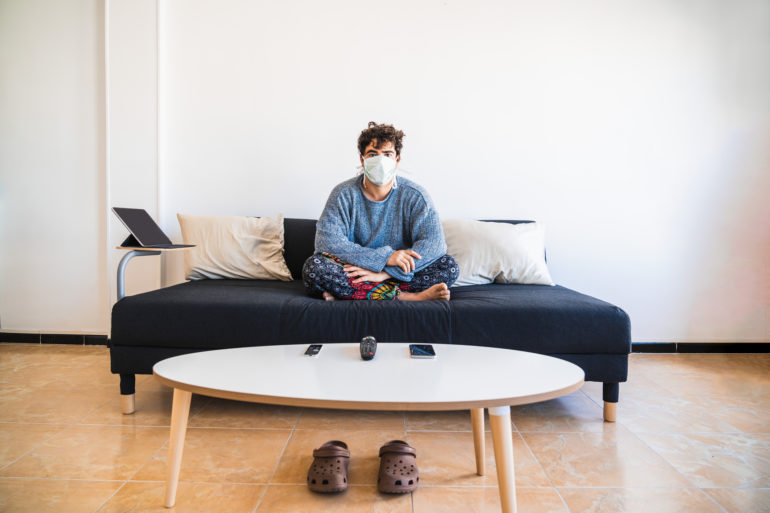New research shows how testing at the end of a quarantine, not just the beginning, could slash isolation time by half, without increasing the risk of onward transmission. The findings have major implications for getting people back to work and school faster.
People who test positive for COVID-19, or who have been exposed to someone who tested positive, are asked to self-isolate in quarantine. In the US, most people receive a COVID-19 test around the time their quarantine starts. But that may be part of the problem. Testing on exit from quarantine, new research shows, is much more important.
“Transmission by people after they’ve left quarantine is a real problem. Quarantine is set up as 14 days based on the World Health Organization guidelines, but it says nothing about testing,” says Burton Singer, a professor in UF’s College of Liberal Arts and Sciences Department of Mathematics. “People go into quarantine based on testing or contact tracing, but they can come out still infectious and become spreaders of COVID-19. The quarantine process doesn’t buy you anything in that case, other than a delay in transmission.”
The US Centers for Disease Control and Prevention cite this new research, which is undergoing peer review, in their web resource Options to reduce quarantine for contacts of persons with SARS-CoV-2 infection using symptom monitoring and diagnostic testing.
Post-quarantine transmission is especially problematic when people have “silent” infections with no visible symptoms. Silent spread may drive around half of all infections, according to earlier research by Singer and his colleagues at the Yale School of Public Health.
Singer, who specializes in modeling infectious disease dynamics, says that research is still unclear on how long people are infectious and that it may vary by person or even by different strains of the SARS-CoV-2 virus which causes COVID-19.
Balancing quarantine and work
Quarantine lengths are problematic for employers whose labor force works or lives in close quarters. Laborers in the energy, farm and service sectors, or those enlisted in the military, face greater risks than people whose work can be performed from the isolation of their own home.
The timing of testing is key. People who are capable of transmitting the disease may be spreading it even after their quarantine has ended. This is because people who may have low viral shedding when they receive a test might yield a negative result, but they may have more advanced shedding by the time they leave a 10 or 14-day quarantine.
“For a lot of corporations, the 14-day quarantine period is completely unacceptable. It costs them a fortune financially,” Singer says. “They are also in a position where COVID-19 spread among their workforce, can be a complete disaster.”
One such corporation, an international energy company that operates offshore oil rigs, contacted Singer’s team with questions about how to optimize testing and quarantine strategies to shorten the confinement period and ensure that workers leaving quarantine wouldn’t threaten the health of their coworkers.
Singer and his colleagues analyzed two different quarantine and testing strategies on two offshore oil rigs for a total of more than 4,000 individuals tested between locations. They found that quarantine times could safely shrink to about seven or eight days when workers were tested at both the beginning and end of their confinement.
“What our work shows is that if you can do just one test, then test on exit. It’s more effective and protective of the population,” Singer says. “You want to ensure a clean exit from quarantine so that those leaving don’t carry the virus back into the greater world.”

This figure from the paper, courtesy of the authors, shows the probability of post-quarantine transmission given different testing scenarios (see colored line key) and days spent in isolation. Panel A assumes 8.3 days incubation period for the virus that causes COVID-19, and panel B assumes 5.2 days.
The researchers modeled scenarios for entering quarantine based on a positive test or due to contact tracing and simulated the model with two different incubation periods (8.3 and 5.2 days). They evaluated the effect of not testing and just quarantining, testing upon entering quarantine, testing at the beginning and end of a quarantine and testing only at the end of a quarantine. They found that in all cases, the pattern of testing at the end of quarantine, with or without a test at the beginning, was most effective in stopping the post-quarantine infectious spread of COVID-19.
Why oil rigs?
Offshore oil rigs are a closed system with little movement of people into and out of the working population for multiple days at a time. Their isolation and captive populations make them ideal for study because public health containment strategies can be tested with minimal external influence.
“On an oil rig, you have a group of people living in very close quarters. One case could lead to infection of everyone who is there. It could cost the company billions in the end,” Singer says.
But the strategies developed from this study can be applied more broadly.
“This is relevant to more than just the fossil fuel industry,” Singer says. “Our findings speak to the economics of our labor force and getting people back to work safely. The worst thing we can do is to only test symptomatic people. That guarantees you will never know where the disease is. It’s the asymptomatics we need to find to facilitate a turn in the tide.”
This story originally appeared on UF Emerging Pathogens Institute.
Check out more stories about UF research on COVID-19.

